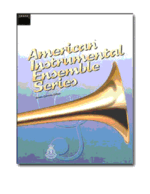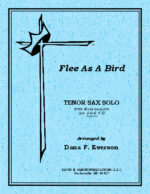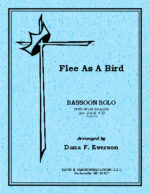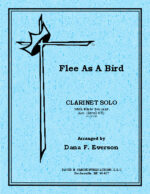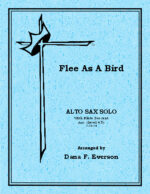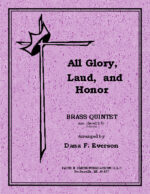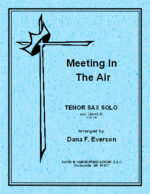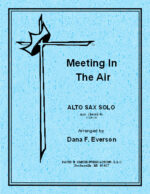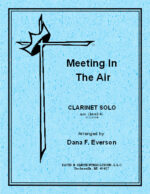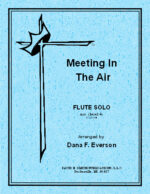-
Life, Joy and Peace (Solo Bb/C)
$9.95Based on the wonderful old gospel song, “‘Tis so Sweet to Trust in Jesus” by Louisa M.R. Snead (1850-1917) and William James Kirkpatrick (1838-1921), this solo with instrumental ensemble accompaniment features one verse and two choruses from the song.
After a brief introduction based on intervals from the song, the soloist plays an original melody by the composer prior to a light and energetic rendition of the first chorus. The verse appears in a more sustained style by the soloist, accompanied by a smooth, chorale-like background.
The second chorus is played by the soloist while the opening original theme is juxtaposed underneath. The introduction is reintroduced prior to an ascending finale by the soloist. -
I Want Jesus To Walk With Me
$29.95African American spirituals are a rich part of our nation’s history – offering songs of hope for the oppressed as well as soulful hymns for the Church. “I Want Jesus to Walk With Me” is one such spiritual. While the text references many trials that must be endured, it maintains a sense of hope. It is a prayer to God to be with us throughout all our life, and with Jesus, we will overcome the trials.
The tune follows a similar pattern. Even though the melody is in a minor key, the repetitive form and quick tempo portray an upbeat thought, despite the trials that are being depicted.
-
Happy Land
$29.95Andrew Young (1807-1891) spent his life in Edinburgh, Scotland where he was a school teacher and head master. Many of Mr. Young’s hymns and poems were published in 1876 as The Scottish Highlands and Other Poems, which included “There Is a Happy Land,” which is included in many hymnals to this day. Its theme of eternal life and peace is summed up in the first verse:
There is a happy land, far, far away,
Where saints in Glory stand, bright, bright as day.
O how they sweetly sing: Worthy is our Savior King!
Loud let His praises ring, praise, praise for aye. -
Grace Alone
$29.95Grace Alone is a simple, lovely, and moving song by Scott Wesley Brown and Jeff Nelson. Its message of hope and assurance is particularly appropriate today. This song also reminds us of Christ’s service and our responsibility to others, admonishing us to “go forth in grace alone.”
-
Fanfare Overture on St. Anne
$29.95The hymn tune “St. Anne” was composed in 1708 by William Croft, the organist at St. Anne’s Church, Soho, London. The words, “O God Our Help in Ages Past” were written by Isaac Watts, also in 1708, as a paraphrase of Psalm 90. For a hymn, the tune is remarkably strong and resolute and has often been used by other composers, notably J. S. Bach and Handel, as the basis for different compositions.
This particular “fanfare overture” setting of the tune is somewhat in keeping with the contrapuntal uses that were in fashion when the tune was originally composed. Instead of standard percussion, for example, timpani alone are used, a reference in style to the celebratory percussion and trumpet combinations of the 18th century.
-
Best Friend Forever
$29.95Colonel Edward H. Joy (1871-1949) had a long career as a Salvation Army officer who served in several administrative appointments in the United Kingdom, Canada, and South Africa from 1894 to 1938. Throughout his ministry, he wrote the words and music to many well-loved songs, including the melody featured here, “All Your Anxiety.” It is a song of invitation, as stated in the chorus:
All your anxiety, all your care,
Bring to the mercy seat, leave it there,
Never a burden He cannot bear,
Never a friend like Jesus. -
Flee As A Bird (with flute descant)
$7.50The piece begins with the solo and descant presenting the tune in unison with few modifications. This texture continues on in this manner allowing the descant to act as a color. The next section is an question/answer form with the soloist alternating against the flute and piano. The third section pairs the solo line and descant in much the same manner as the opening. The piece comes to a subtle conclusion. The piece, as a whole depicts a bird flying and flittering about in glee.
-
Flee As A Bird (with flute descant)
$7.50The piece begins with the solo and descant presenting the tune in unison with few modifications. This texture continues on in this manner allowing the descant to act as a color. The next section is an question/answer form with the soloist alternating against the flute and piano. The third section pairs the solo line and descant in much the same manner as the opening. The piece comes to a subtle conclusion. The piece, as a whole depicts a bird flying and flittering about in glee.
-
Flee As A Bird (with flute descant)
$7.50The piece begins with the solo and descant presenting the tune in unison with few modifications. This texture continues on in this manner allowing the descant to act as a color. The next section is an question/answer form with the soloist alternating against the flute and piano. The third section pairs the solo line and descant in much the same manner as the opening. The piece comes to a subtle conclusion. The piece, as a whole depicts a bird flying and flittering about in glee.
-
Flee As A Bird (with flute descant)
$7.50The piece begins with the solo and descant presenting the tune in unison with few modifications. This texture continues on in this manner allowing the descant to act as a color. The next section is an question/answer form with the soloist alternating against the flute and piano. The third section pairs the solo line and descant in much the same manner as the opening. The piece comes to a subtle conclusion. The piece, as a whole depicts a bird flying and flittering about in glee.
-
-
-
-
-
All Glory, Laud and Honor
$13.00For brass quintet and optional piano and substitute brass parts. After a brief introduction the theme is presented in an echoing fashion giving a great deal of texture. A modulation takes place and the texture is more block and majestic with rhythmic movements. More modulation occurs and the meter now changes as well and again the melodic material is passed around the ensemble in an almost free form. The coda quickly shifts back to the original meter and the piece becomes quite rhythmic leading up to a final conclusive figure.
-
Meeting In The Air
$5.50A tenor sax solo that is lively and exciting from beginning to the end. A brief introduction sets up the flavor for a modified presentation of the tune. After a modulation the second offering is more sedate and sweet. Only to be answered with a vigorous flair. Another modulation and a more expressive style where it moves upward to an elevated conclusion.
-
Meeting In The Air
$5.50An alto sax solo that is lively and exciting from beginning to the end. A brief introduction sets up the flavor for a modified presentation of the tune. After a modulation the second offering is more sedate and sweet. Only to be answered with a vigorous flair. Another modulation and a more expressive style where it moves upward to an elevated conclusion.
-
Meeting In The Air
$5.50A clarinet solo that is lively and exciting from beginning to the end. A brief introduction sets up the flavor for a modified presentation of the tune. After a modulation the second offering is more sedate and sweet. Only to be answered with a vigorous flair. Another modulation and a more expressive style where it moves upward to an elevated conclusion.
-
Meeting In The Air
$5.50A flute solo that is lively and exciting from beginning to the end. A brief introduction sets up the flavor for a modified presentation of the tune. After a modulation the second offering is more sedate and sweet. Only to be answered with a vigorous flair. Another modulation and a more expressive style where it moves upward to an elevated conclusion.
-
Back To The Bible
$6.95Overview of Music in God’s Mind; Context Summarized; Explanatory Footnores; Helpful Appendices, Chronological Arrangements
-
-
Variations on “Turro” (Lift Up Your Heads”
$29.95These short variations are a lively upbeat rendition on the tune “Truro.” The tune “Truro” first appeared in Psalmodia Evangelica, a two-volume collection of psalm and hymn tunes published in 1789. The tune is named for the city in Cornwall, England with its striking Anglican cathedral. This arrangement is based on these words:
Lift up your heads, ye mighty gates,
-
Kingsfold
$29.95“Kingsfold” is a traditional English melody, possibly originating in the Middle Ages. It was included in an anthology, English Country Songs, at the end of the 19th century. Ralph Vaughan Williams heard the tune in Kingsfold, Sussex (hence its name) and included it as a hymn tune in The English Hymnal (1906) to the words “I Heard the Voice of Jesus Say” by Horatius Bonar (1808-1889).
-
Consolation (Come Ye Disconsolatee)
$29.95In the first chapter of Mark’s Gospel, we read an amazing story of many people who were physically and mentally ill being brought to Jesus to be healed. This drew the attention of the entire village who came out to witness Jesus and left amazed at what they saw. Covid 19 has caused many to be both physically and mentally ill, requiring healing.
This meditation seeks to portray, through music, this coming to Jesus to be healed, using this hymn by Thomas Moore (1779-1852):

